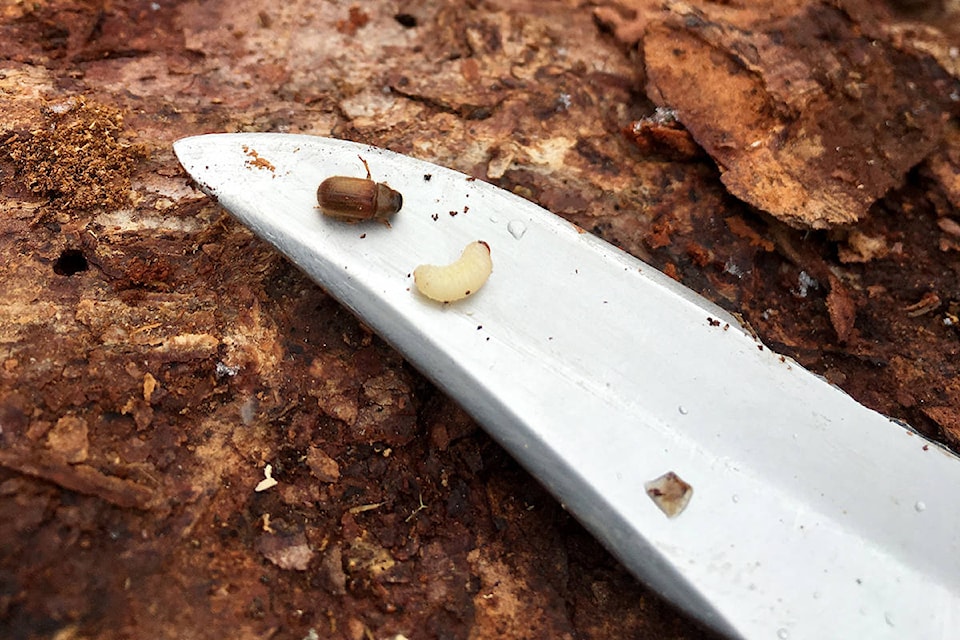In the previous article in this series, Jeanne Robert said the Ministry of Forests (MOF) has some concerns about the current spruce beetle infestation in the northern Interior.
The Omineca-Northwest regional entomologist for the Ministry of Forests, Lands, Natural Resource Operations and Rural Development explained the ministry detected higher than normal populations of spruce beetle north of Prince George and around Mackenzie in 2014.
It has spread from 150,000 hectares coverage in the Omineca region in 2015 to 340,000 ha in 2017.
She noted it’s not unusual for spruce beetles to reach a population threshold and then move from dead and dying trees into healthier, standing green spruce trees.
This allows the smaller trees to grow to maturity and maintain the ecosystem’s diverse age and trees species.
Outbreak concerns
However, Robert noted the MOF is closely watching with this current spruce beetle outbreak because it is happening within the context of climate change.
“We have climate and weather patterns [good for all bark beetles] we haven’t seen historically for spruce beetle.
“With the warmer, drier summers and milder, warmer winters, we don’t have the historical cold snap in early winter to kill off a large portion of the spruce beetle population that’s beginning to rise.”
That has allowed the spruce beetle to get a toehold, Robert added.
Attack detection
Robert said it is difficult to monitor the beetle spread because it can take 13 to 18 months for the trees to change colour and can be seen from the air.
The entomologist noted the ministry uses low-level helicopter surveys in areas of new red-coloured spruce trees.
If they come back with reports of more red trees, she added they will follow up with ground surveys.
Meanwhile, the MOF has expanded the ground survey program to the Dawson Creek and Chetwynd areas this year.
Along with monitoring the spread, she noted the ministry wants to facilitate solutions for the march of this pesky bark beetle.
Mitigation plans
Robert said the ministry has two goals while mitigating the outbreak – protecting the Mid-term Timber Supply and making sure there is a balanced and collaborative approach slowing the spruce beetle spread.
She added the MOF has Timber Supply Working Groups in the affected areas.
“We have one in Prince George; one in Mackenzie and one in the Northeast and one in the Robson Valley [nestled against the Rocky Mountains from Dome Creek in the north to Valemount in the south].
“The role of the working groups is to bring all of the licensees to one table to work out a collaborative approach to best mitigate the outbreak [with the ministry].
“This is the ministry’s most effective tool because it’s a joint government-licensee action plan.”
The plan is to prioritize areas for “sanitation harvesting,” which is where they cut down green beetle-attacked trees and try to remove the live beetles from those trees and stands, Robert added.
“We know where the attack is happening because of the aerial, helicopter and ground surveys, so we know where we will have the most impact on mitigation the beetle population.
“It depends on the licensees’ operating areas, and what’s accessible now versus what can be accessible in the next two to five years.”
Accessibility is one of the big constraints for the mitigation plan. Roads and other infrastructure have to be built to get access to spruce beetle-infested areas.
Forest priorities
Furthermore, there is the issue of high priority in the spruce beetle ecosystems, Robert noted.
“There’s not just spruce beetle out there in the timber-harvesting land base.
“There are a lot of non-timber values that are very important to managing the forests as a whole.”
While the goal is to mitigate the spruce beetle attack on the Mid-term Timber Supply, it’s also a goal to balance that with the non-timber values, Robert said, adding the balancing is done at the operational level.
The non-timber values include caribou, ungulate winter range, fisheries, sensitive watersheds, old-growth management areas and other habitat-sensitive issues.
“It has to be looked at in a holistic way. We simply can’t chase after just spruce beetle….
“Those are the questions we struggle with at the working group level, that’s why we call it the operational level. We call that our Joint Licensee Government Action Plan.”
For details on the mitigation plans for the spruce beetle spread in the Cariboo, read part 4 of the series in the Observer next Wednesday, May 2.
READ MORE: Current spruce beetle outbreak in Omineca region not unusual
READ MORE: Past data shows spruce beetle outbreaks are a natural occurence
